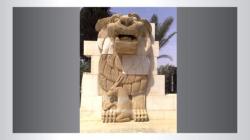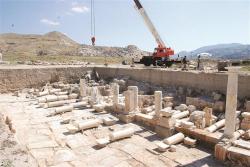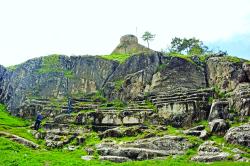INSTITUT SUPERIEUR D'ANTHROPOLOGIE
INSTITUTE OF ANTHROPOLOGY
ONLINE COURSES / COURS A DISTANCE
FALL TERM : OCTOBER 2015
REGISTER NOW
SYRIE –  Palmyre - Les combattants de l'Etat islamique ont détruit la statue du lion de Palmyre, emblème de la ville. Une pièce unique qui datait du 1er siècle avant JC. La fameuse statue qui veillait sur l’entrée du musée de la ville a disparu, réduite à l’état d’un tas de cailloux par les combattants de l’Etat islamique. Cette statue monumentale, de 3 mètres de haut, datait du 1er siècle avant JC. Son poids est estimé à une quinzaine de tonnes. La statue en calcaire, pièce unique, a été mise à jour en 1977 par une mission archéologique polonaise dans le temple d'Al-Lat. Al-Lat, une déesse préislamique, avait été assimilée à Athéna au moment de l'apogée de Palmyre, au IIIe siècle après JC, ce qui explique que la statue soit souvent nommée Lion d'Athéna. Mais le culte de la déesse préislamique avait duré jusqu'à l'époque de Mahomet, qui combattait ses adeptes.
Palmyre - Les combattants de l'Etat islamique ont détruit la statue du lion de Palmyre, emblème de la ville. Une pièce unique qui datait du 1er siècle avant JC. La fameuse statue qui veillait sur l’entrée du musée de la ville a disparu, réduite à l’état d’un tas de cailloux par les combattants de l’Etat islamique. Cette statue monumentale, de 3 mètres de haut, datait du 1er siècle avant JC. Son poids est estimé à une quinzaine de tonnes. La statue en calcaire, pièce unique, a été mise à jour en 1977 par une mission archéologique polonaise dans le temple d'Al-Lat. Al-Lat, une déesse préislamique, avait été assimilée à Athéna au moment de l'apogée de Palmyre, au IIIe siècle après JC, ce qui explique que la statue soit souvent nommée Lion d'Athéna. Mais le culte de la déesse préislamique avait duré jusqu'à l'époque de Mahomet, qui combattait ses adeptes.
VIDEO = https://fr.news.yahoo.com/le-lion-de-palmyre-reduit-ruines-par-etat-islamique-091616591.html?vp=1
USA –  Colonial Michilimackinac - Archaeologists have discovered a Roman Catholic rosary in northern Michigan that could be 250 years old. The Grand Rapids Press says the rosary was discovered last week at Colonial Michilimackinac, a reconstructed fort and fur trading post dating to the 1700s. It is along the Straits of Mackinac at the tip of the Lower Peninsula. The rosary, found by James Dunnigan, is made with ivory beads and brass links. Dunnigan was excavating at the home of fur trader Charles Gonneville. Lynn Evans, curator of archaeology for Mackinac State Historic Parks, estimates the age at 250 years old. She says "there's got to be an intriguing story" behind the rosary. Under Catholic tradition, the rosary is held while a person prays and reflects on the life of Jesus Christ.
Colonial Michilimackinac - Archaeologists have discovered a Roman Catholic rosary in northern Michigan that could be 250 years old. The Grand Rapids Press says the rosary was discovered last week at Colonial Michilimackinac, a reconstructed fort and fur trading post dating to the 1700s. It is along the Straits of Mackinac at the tip of the Lower Peninsula. The rosary, found by James Dunnigan, is made with ivory beads and brass links. Dunnigan was excavating at the home of fur trader Charles Gonneville. Lynn Evans, curator of archaeology for Mackinac State Historic Parks, estimates the age at 250 years old. She says "there's got to be an intriguing story" behind the rosary. Under Catholic tradition, the rosary is held while a person prays and reflects on the life of Jesus Christ.
http://www.wilx.com/news/headlines/Old-Rosary-Found-At-Fort-311548131.html
TURQUIE –  Tripolis - Structures from 1,900 years ago have been unearthed during archaeological excavations in the ancient city of Tripolis, located in the western province of Denizli’s Buldan district. The structures were used as granaries, according to officials. The archaeological excavations have been ongoing in Tripolis, located on a triangle of Phrygia, Karia and Lydia. The head of the excavations, Pamukkale University Archaeology Department member Associated Professor Bahadır Duman, said this year’s work had begun in the ancient city in March, adding a surface survey proved the region dated back to 5,000 years ago and had been reestablished in the 2nd century. “The area of granaries is one of the fields where we are working this year. It is made up of two buildings attached to each other. Tripolis is located along a plain watered by the Menderes River. Therefore, these granaries show us that agricultural activities were also carried out in the ancient ages. We analyze these structures with the support of academics from biology and geology departments. We are working to find out what kinds of grains were produced there,” he said. Duman said they estimated the granaries were built in the Roman era. “We expect to find other granaries. We have made geo-radar work. First examinations show that there were more granaries,” he said.
Tripolis - Structures from 1,900 years ago have been unearthed during archaeological excavations in the ancient city of Tripolis, located in the western province of Denizli’s Buldan district. The structures were used as granaries, according to officials. The archaeological excavations have been ongoing in Tripolis, located on a triangle of Phrygia, Karia and Lydia. The head of the excavations, Pamukkale University Archaeology Department member Associated Professor Bahadır Duman, said this year’s work had begun in the ancient city in March, adding a surface survey proved the region dated back to 5,000 years ago and had been reestablished in the 2nd century. “The area of granaries is one of the fields where we are working this year. It is made up of two buildings attached to each other. Tripolis is located along a plain watered by the Menderes River. Therefore, these granaries show us that agricultural activities were also carried out in the ancient ages. We analyze these structures with the support of academics from biology and geology departments. We are working to find out what kinds of grains were produced there,” he said. Duman said they estimated the granaries were built in the Roman era. “We expect to find other granaries. We have made geo-radar work. First examinations show that there were more granaries,” he said.
http://www.hurriyetdailynews.com/ancient-granaries-found-in-denizli.aspx?pageID=238&nID=84951&NewsCatID=375
ROYAUME UNI –  Bannockburn - Archaeologists are set to continue their search for historic evidence from the 701 year old 1314 Battle of Bannockburn at the official site. Over the past two years, a team from the National Trust for Scotland and Glasgow University archaeology department have undertaken digs around the Borestone, Bannock Burn and Carse areas in Stirling, intended to help uncover evidence that will finally pinpoint the battlefield and explain more about the events of seven centuries ago. Now attention is turning to the campsite where Robert the Bruce and his men spent the night before the battle, which is believed to be close to the commemorative monuments – the rotunda, flagpole, memorial cairn and equestrian statue which are on the Stirling site.
Bannockburn - Archaeologists are set to continue their search for historic evidence from the 701 year old 1314 Battle of Bannockburn at the official site. Over the past two years, a team from the National Trust for Scotland and Glasgow University archaeology department have undertaken digs around the Borestone, Bannock Burn and Carse areas in Stirling, intended to help uncover evidence that will finally pinpoint the battlefield and explain more about the events of seven centuries ago. Now attention is turning to the campsite where Robert the Bruce and his men spent the night before the battle, which is believed to be close to the commemorative monuments – the rotunda, flagpole, memorial cairn and equestrian statue which are on the Stirling site.
http://www.scotsman.com/lifestyle/heritage/archaeologists-to-dig-for-bannockburn-secrets-1-3820614
USA –  Tibradden Station - Jayden van Beek and an archaeology team from UWA have been exploring the more recent past at one of the areas oldest farming settlements in the Midwest, Tibradden Station. The site was documented but no one was sure what the site had originally been used for and how it had been modified.
Tibradden Station - Jayden van Beek and an archaeology team from UWA have been exploring the more recent past at one of the areas oldest farming settlements in the Midwest, Tibradden Station. The site was documented but no one was sure what the site had originally been used for and how it had been modified.
http://www.abc.net.au/local/videos/2015/07/03/4267169.htm
TURQUIE –  Zile - The last amphitheater of the northern Anatolian region will be unearthed in an excavation in Turkey’s province of Tokat. The amphitheater is located just east of the historic castle of Zile, a city with a long Roman history and battle that prompted Roman Emperor Julius Caesar’s famous phrase, “veni, vidi, vici” (I came, I saw, I conquered). Zile Mayor Lütfi Vidinel said Zile was home to many ancient castles. He said that the Roman people had built meeting places in the shapes of amphitheaters, as “these meeting areas are half-rounded places with steps.” According to historical documents, Caesar waged a bloody battle against Pharnaces II in Zile’s region of Altıağaç. Although both sides suffered losses during the battle, Casesar turned it into a quick Roman victory, thus inspiring the words “veni, vidi, vici,” sent via letter to the Roman senate. He also built a stone tablet and inscribed these words upon it.
Zile - The last amphitheater of the northern Anatolian region will be unearthed in an excavation in Turkey’s province of Tokat. The amphitheater is located just east of the historic castle of Zile, a city with a long Roman history and battle that prompted Roman Emperor Julius Caesar’s famous phrase, “veni, vidi, vici” (I came, I saw, I conquered). Zile Mayor Lütfi Vidinel said Zile was home to many ancient castles. He said that the Roman people had built meeting places in the shapes of amphitheaters, as “these meeting areas are half-rounded places with steps.” According to historical documents, Caesar waged a bloody battle against Pharnaces II in Zile’s region of Altıağaç. Although both sides suffered losses during the battle, Casesar turned it into a quick Roman victory, thus inspiring the words “veni, vidi, vici,” sent via letter to the Roman senate. He also built a stone tablet and inscribed these words upon it.
http://www.hurriyetdailynews.com/last-northern-anatolian-amphitheater-to-be-unearthed.aspx?pageID=238&nID=84888&NewsCatID=375
ROYAUME UNI - Shetland - 100,000 archaeological artefacts, dating from as far back as 6,000 BC and including evidence of the earliest human civilisation on the isles, have journeyed home to Shetland to be included in the Recognised Archaeology Collection of Shetland Museum and Archives. Excavated from the Dunrossness area, they feature 6,000-year-old shards of pottery - the oldest found on Shetland. The shards were discovered in West Voe in two shell middens, where the debris of ancient meals accumulated. A wealth of different objects has also been returned from excavations at Old Scatness. Dating on a barley grain and a bone from under the Broch confirmed dates of between 400–200BC for its construction. Five Pictish buildings were later added above the Broch village. Conducted between 1995 and 2006 around the broch - a unique Scottish style of Iron Age tower - the excavations were the most intensive ever held in Shetland, yielding 40,000 small finds and more than 50,000 pieces of pottery. Artefacts uncovered included animal and fish bones, stone tools, painted pebbles, pottery, coins, beads, Roman glass and carved stones such as the Scatness Bear and the Grice.
http://www.culture24.org.uk/history-and-heritage/archaeology/art530962-archaeologists-create-prehistoric-treasure-trove-of-earliest-evidence-left-by-humans-on-shetland?
PORTUGAL – Lagos - The skeleton of a Roman woman who died almost 2,000 years ago has been dug up in the historic centre of Lagos. The woman, who is thought to have died aged around 30 or 40 was found buried on Rua da Oliveira by council archaeologists as they took advantage of road works to carry out a dig. It is the second such skeleton to be found in that city in less than a decade. The area in which it was found is believed to have been an old Roman cemetery.
http://theportugalnews.com/news/roman-skeleton-found-in-lagos/35245?
KYRGYSTAN – Tuura-Suu - Scientists of Kyrgyzstan and Russia started joint archeological excavations on the southern shore of Lake Issyk-Kul. They believe to find the evidence of existence of an ancient capital of the Kyrgyz principality on the territory of the modern village of Tuura-Suu, Ton district. Scientific supervisor of the archeological complex “Stoyanka Omskaya ” is Candidate of Historical Sciences, Professor Boris Konikov. Study of Kyrgyzstan began three years ago under the agreement on long-term cooperation signed in August 2012 with the Interstate Development Corporation and the Institute of Archeology and Ethnography of the Siberian Branch of the Russian Academy of Sciences (RAS). “We want to find the evidence that Turaa-Suu was the site for the large principality in the Middle Ages, as stated by some written sources,” said Konikov. “Archeological finds can help to find out what was the standard of living of the Kyrgyz people back then, development of handicrafts, trade ties and civil engineering at the time. During the excavations, we expect to make a number of discoveries that will complement the ancient history with new interesting details.” The expedition to Lake Issyk-Kul involves experts from the RAS Institute of Archeology and Ethnography, the Kyrgyz-Russian Slavic University and the Kyrgyzstan-Turkey Manas University. Archeologists plan to open several reservoirs located at a depth of 15 meters and find over 3 thousand artefacts. Excavations will last for a month. Afterwards, the archeological finds will be transferred to Bishkek to describe, organize and study them in detail. Results of the season will be summed up in October.
http://www.akipress.com/news:561338/?